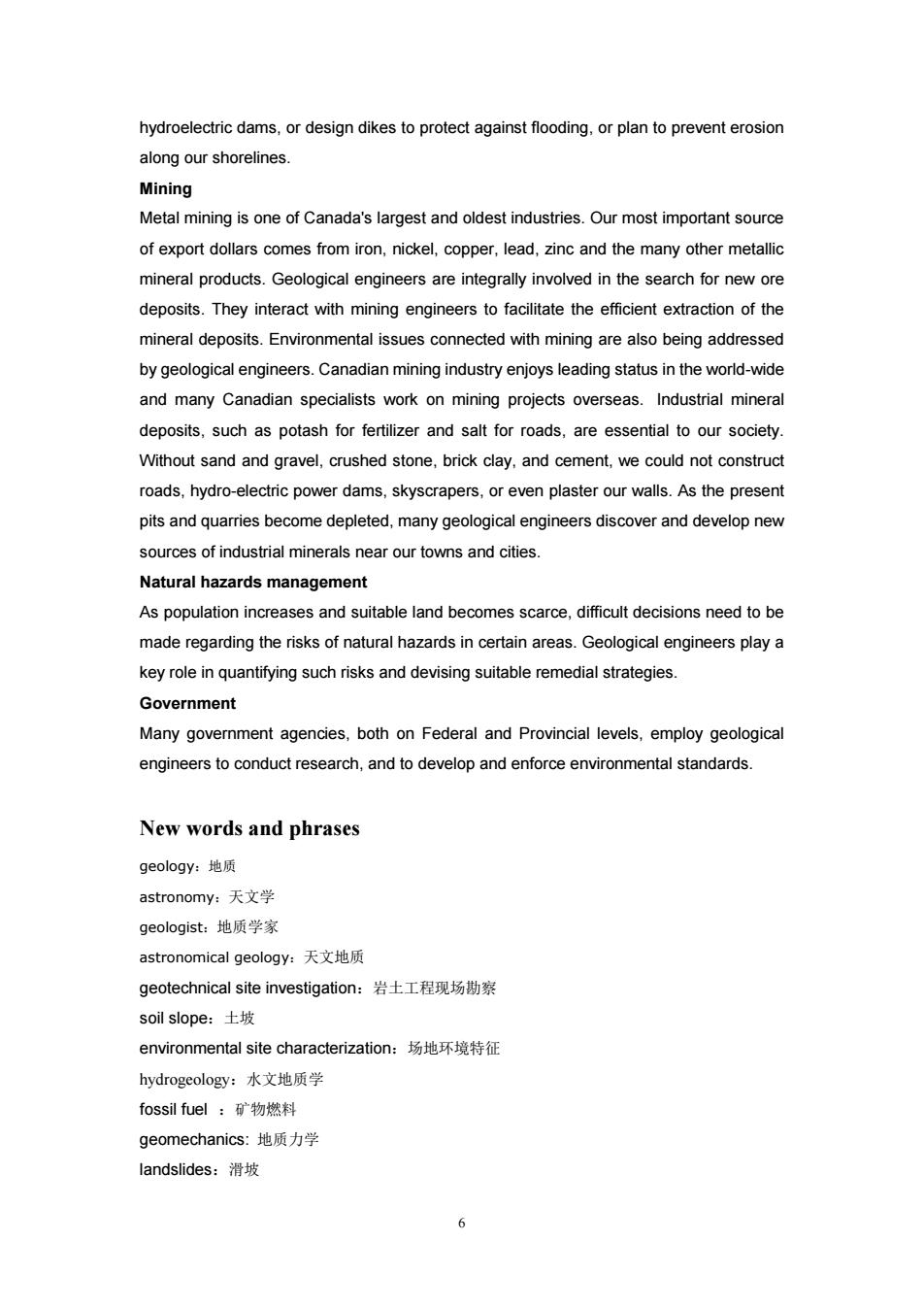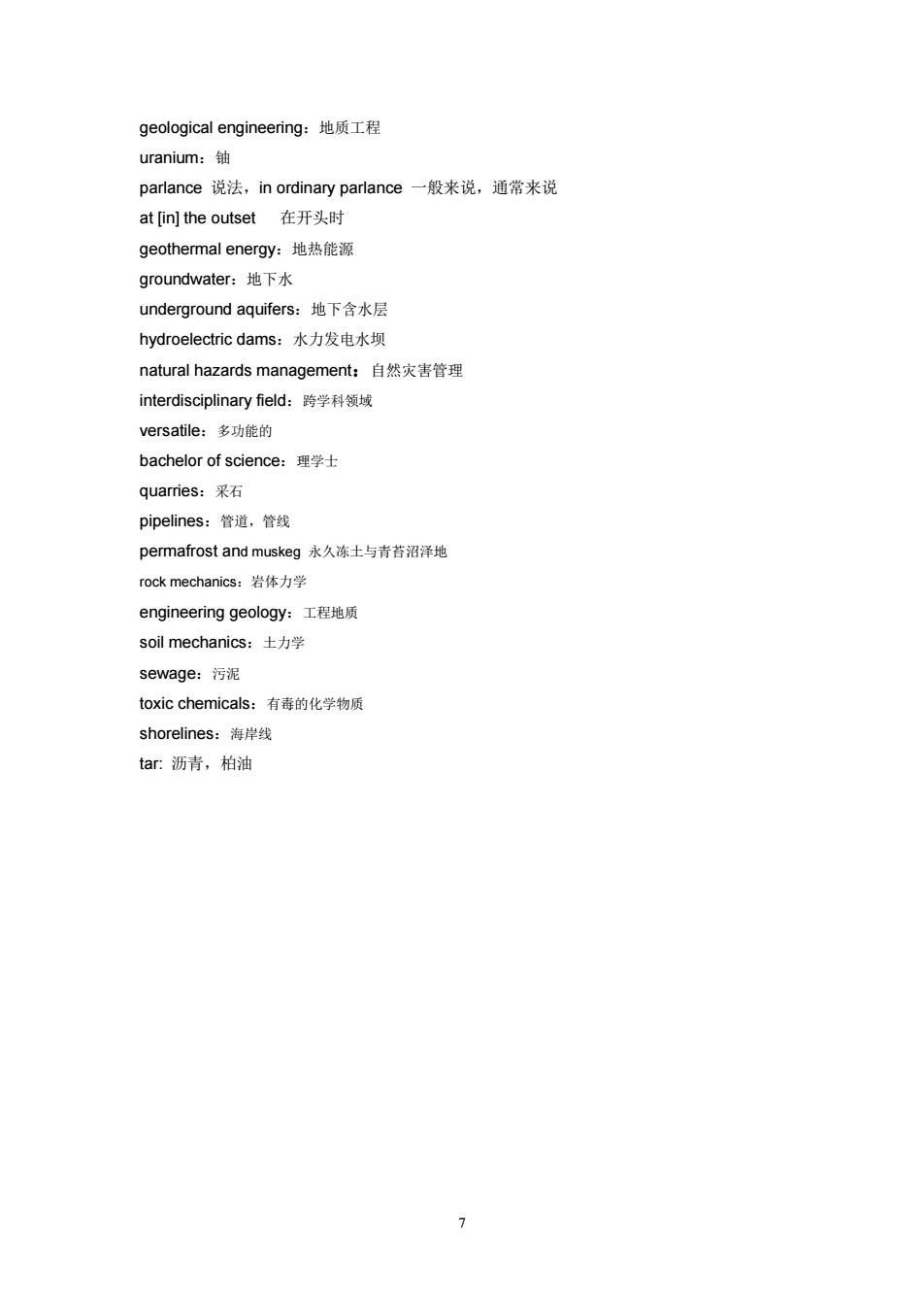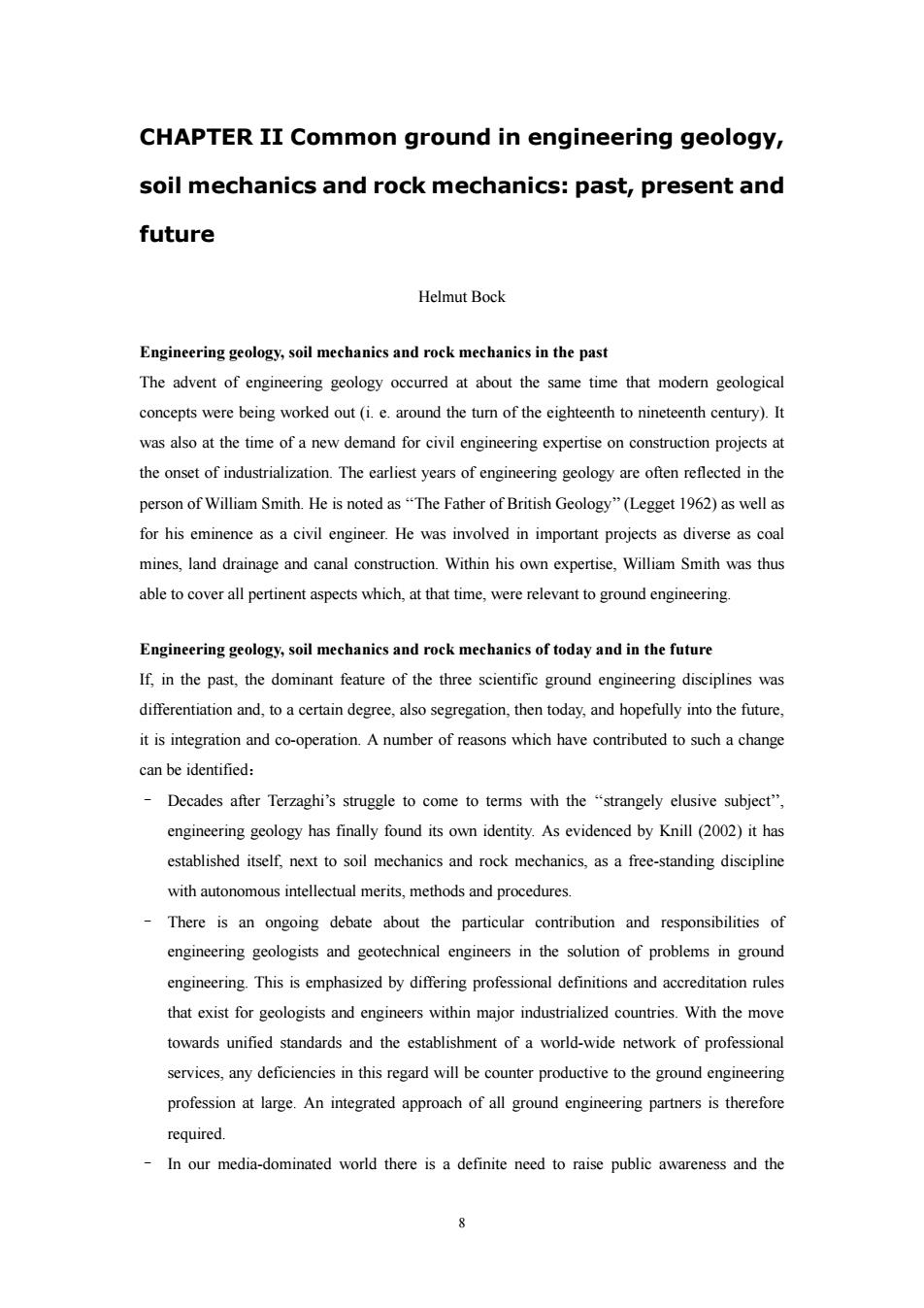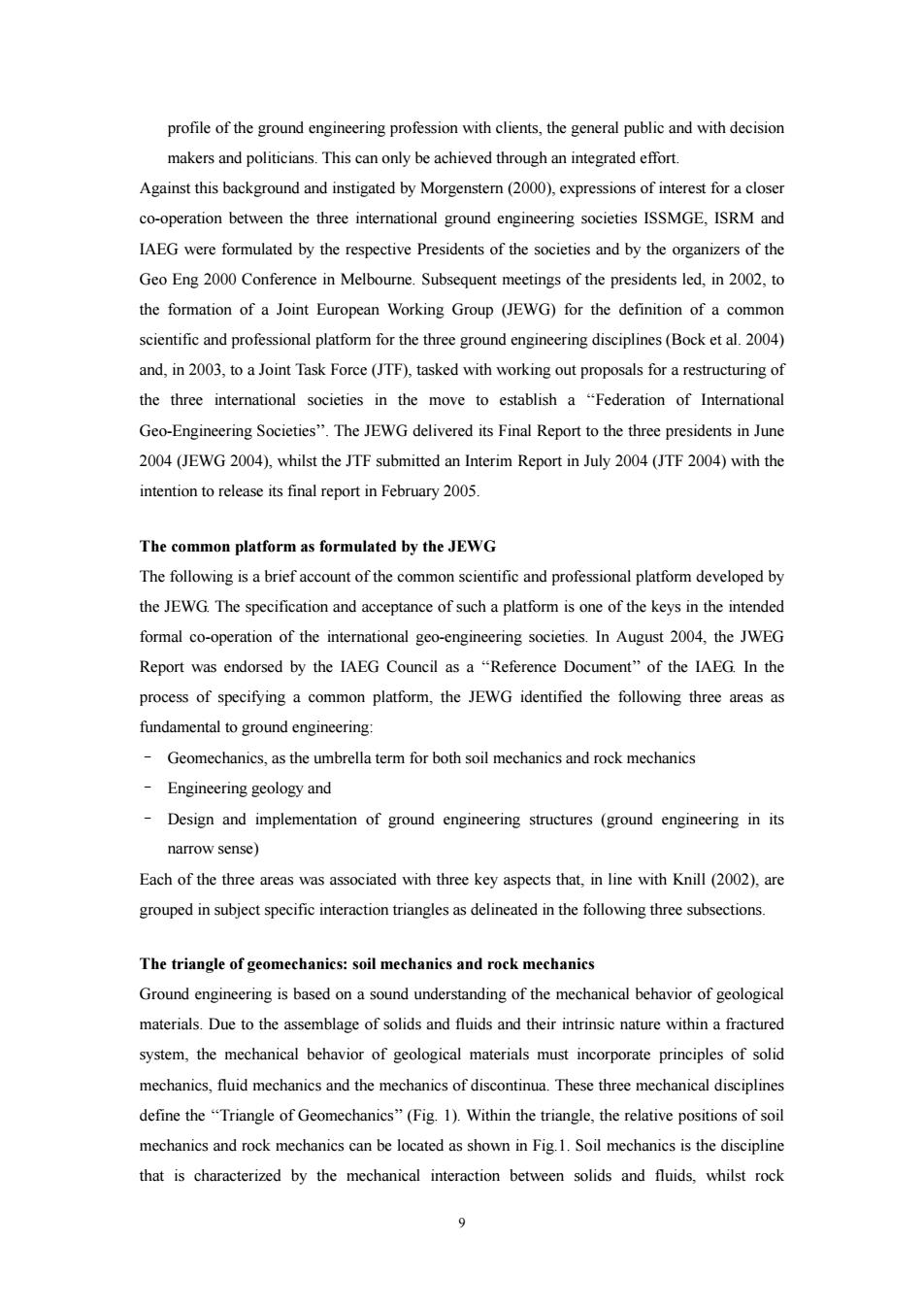
Environmental Protection Protection of the environment is one of the greatest challenges facing modem society.As new types of pollution are detected,engineers must develop new solutions to cure the problems.Geological engineers have a crucial role because of their knowledge of how the earth reacts to various engineering processes.With increasing value of land.demand for innovative solutions such as the use of underground space will grow steadily.Highly talented engineers are needed to design and construct excavations and tunnels and to safely dispose of garbage,sewage,and toxic chemicals. Building and maintenance of roads,railways,airports,transmission lines and pipelines in the challenging terrain characteristic of many parts of Canada require an enormous amount of expert input from geological engineers.These needs are likely to become even stronger in the future.as transportation standards for safety.reliability and capacity increase.For example,recent building of high speed rail lines,in the European countries and Japan represents one of the greatest geological engineering challenges ever faced. In this country.we will be facing similar challenges in the near future. Energy Energy-we have all become aware of Canada's continuing struggle to meet its energy needs.Energy is essential for heating,transportation,manufacturing,and most other aspects of our life.We cannot afford to be complacent because we import as much energy in the form of oil,gas,and coal and uranium as we export.Hundreds of geological engineers are involved in multi-billion dollar exploration programs to find more resources. These include:oil and gas in Western Canada,the Arctic and off the East Coast;uranium in Saskatchewan:tar sands in Alberta;coal in the Rocky Mountains and Maritimes:and geothermal energy in British Columbia.Geological engineers also work as reservoir engineers.pit engineers and mine geologists in the production of these resources.Other important issues connected with energy production are the safety of facilities in the event of earthquakes and other natural disasters,and risk to the environment,connected with pollution from thermal energy plants and the disposal of waste from nuclear reactors.All of these issues require input from geological engineers. Water Water is the most essential mineral commodity used by man.Thus groundwater is an important realm of geological engineering.In many parts of Canada such as the Prairies. the location of industry and the irrigation of farms depends on a reliable and abundant source of good water.This often requires dams for watershed management or drilling to tap underground aquifers.Some geological engineers regulate water supply for
5 Environmental Protection Protection of the environment is one of the greatest challenges facing modern society. As new types of pollution are detected, engineers must develop new solutions to cure the problems. Geological engineers have a crucial role because of their knowledge of how the earth reacts to various engineering processes. With increasing value of land, demand for innovative solutions such as the use of underground space will grow steadily. Highly talented engineers are needed to design and construct excavations and tunnels and to safely dispose of garbage, sewage, and toxic chemicals. Building and maintenance of roads, railways, airports, transmission lines and pipelines in the challenging terrain characteristic of many parts of Canada require an enormous amount of expert input from geological engineers. These needs are likely to become even stronger in the future, as transportation standards for safety, reliability and capacity increase. For example, recent building of high speed rail lines, in the European countries and Japan represents one of the greatest geological engineering challenges ever faced. In this country, we will be facing similar challenges in the near future. Energy Energy - we have all become aware of Canada's continuing struggle to meet its energy needs. Energy is essential for heating, transportation, manufacturing, and most other aspects of our life. We cannot afford to be complacent because we import as much energy in the form of oil, gas, and coal and uranium as we export. Hundreds of geological engineers are involved in multi-billion dollar exploration programs to find more resources. These include: oil and gas in Western Canada, the Arctic and off the East Coast; uranium in Saskatchewan; tar sands in Alberta; coal in the Rocky Mountains and Maritimes; and geothermal energy in British Columbia. Geological engineers also work as reservoir engineers, pit engineers and mine geologists in the production of these resources. Other important issues connected with energy production are the safety of facilities in the event of earthquakes and other natural disasters, and risk to the environment, connected with pollution from thermal energy plants and the disposal of waste from nuclear reactors. All of these issues require input from geological engineers. Water Water is the most essential mineral commodity used by man. Thus groundwater is an important realm of geological engineering. In many parts of Canada such as the Prairies, the location of industry and the irrigation of farms depends on a reliable and abundant source of good water. This often requires dams for watershed management or drilling to tap underground aquifers. Some geological engineers regulate water supply for

hydroelectric dams,or design dikes to protect against flooding.or plan to prevent erosion along our shorelines. Mining Metal mining isone of Canada's largest and oldest industries.Our most important source of export dollars comes from iron.nickel,copper.lead,zinc and the many other metallic mineral products.Geological engineers are integrally involved in the search for new ore deposits.They interact with mining engineers to facilitate the efficient extraction of the mineral deposits.Environmental issues connected with mining are also being addressed by geological engineers.Canadian mining industry enjoys leading status in the world-wide and many Canadian specialists work on mining projects overseas.Industrial mineral deposits,such as potash for fertilizer and salt for roads,are essential to our society. Without sand and gravel,crushed stone.brick clay,and cement.we could not construct roads.hydro-electric power dams,skyscrapers,or even plaster our walls.As the present pits and quarries become depleted,many geological engineers discover and develop new sources of industrial minerals near our towns and cities Natural hazards management As population increases and suitable land becomes scarce,difficult decisions need to be made regarding the risks of natural hazards in certain areas.Geological engineers play a key role in quantifying such risks and devising suitable remedial strategies Government Many government agencies,both on Federal and Provincial levels,employ geological engineers to conduct research,and to develop and enforce environmental standards. New words and phrases geology::地质 astronomy:天文学 geologist:地质学家 astronomical geology:天文地质 geotechnical site investigation:岩土工程现场勘黎 soil slope:土坡 environmental site characterization:场地环境特征 hydrogeology:水文地质学 fossil fuel:矿物燃料 geomechanics:地质力学 landslides:滑坡
6 hydroelectric dams, or design dikes to protect against flooding, or plan to prevent erosion along our shorelines. Mining Metal mining is one of Canada's largest and oldest industries. Our most important source of export dollars comes from iron, nickel, copper, lead, zinc and the many other metallic mineral products. Geological engineers are integrally involved in the search for new ore deposits. They interact with mining engineers to facilitate the efficient extraction of the mineral deposits. Environmental issues connected with mining are also being addressed by geological engineers. Canadian mining industry enjoys leading status in the world-wide and many Canadian specialists work on mining projects overseas. Industrial mineral deposits, such as potash for fertilizer and salt for roads, are essential to our society. Without sand and gravel, crushed stone, brick clay, and cement, we could not construct roads, hydro-electric power dams, skyscrapers, or even plaster our walls. As the present pits and quarries become depleted, many geological engineers discover and develop new sources of industrial minerals near our towns and cities. Natural hazards management As population increases and suitable land becomes scarce, difficult decisions need to be made regarding the risks of natural hazards in certain areas. Geological engineers play a key role in quantifying such risks and devising suitable remedial strategies. Government Many government agencies, both on Federal and Provincial levels, employ geological engineers to conduct research, and to develop and enforce environmental standards. New words and phrases geology:地质 astronomy:天文学 geologist:地质学家 astronomical geology:天文地质 geotechnical site investigation:岩土工程现场勘察 soil slope:土坡 environmental site characterization:场地环境特征 hydrogeology:水文地质学 fossil fuel :矿物燃料 geomechanics: 地质力学 landslides:滑坡

geological engineering:地质工程 uranium:铀 parlance说法,in ordinary parlance一般来说,通常来说 at [in]the outset在开头时 geothermal energy:地热能源 groundwater:地下水 underground aquifers:地下含水层 hydroelectric dams:水力发电水坝 natural hazards management:自然灾告管理 interdisciplinary field:跨学科领域 versatile:多功能的 bachelor of science:理学士 quarries:采石 pipelines:管道,管线 permafrost and muskeg永久冻土与青苔沼泽地 rock mechanics:岩体力学 engineering geology:工程地质 soil mechanics:土力学 sewage:污泥 toxic chemicals:有毒的化学物质 shorelines:海岸线 tar:沥青,柏油
7 geological engineering:地质工程 uranium:铀 parlance 说法,in ordinary parlance 一般来说,通常来说 at [in] the outset 在开头时 geothermal energy:地热能源 groundwater:地下水 underground aquifers:地下含水层 hydroelectric dams:水力发电水坝 natural hazards management:自然灾害管理 interdisciplinary field:跨学科领域 versatile:多功能的 bachelor of science:理学士 quarries:采石 pipelines:管道,管线 permafrost and muskeg 永久冻土与青苔沼泽地 rock mechanics:岩体力学 engineering geology:工程地质 soil mechanics:土力学 sewage:污泥 toxic chemicals:有毒的化学物质 shorelines:海岸线 tar: 沥青,柏油

CHAPTER II Common ground in engineering geology, soil mechanics and rock mechanics:past,present and future Helmut Bock Engineering geology,soil mechanics and rock mechanics in the past The advent of engincering geology occurred at about the same time that modem geological concepts were being worked out (i.e.around the tum of the eighteenth to nineteenth century).It was also at the time of a new demand for civil engineering expertise on construction projects at the onset of industrialization.The earliest years of engineering geology are often reflected in the person of William Smith.He is noted as"The Father of British Geology"(Legget 1962)as well as for his eminence as a civil engineer.He was involved in important projects as diverse as coal mines,land drainage and canal construction.Within his own expertise,William Smith was thus able pertinent aspects whichat that time.ere relevant toground Engineering geology,soil mechanics and rock mechanies of today and in the future If.in the past,the dominant feature of the three scientific ground engineering disciplines was differentiation and,to acertain degree.also segregation,then today.and hopefully into the future. it is integration and cooperation.A number of reasons which have contributed to such a change can be identified: Decades after Terzaghi's struggle to come to terms with the"strangely elusive subject", engineering geology has finally found its own identity.As evidenced by Knill (2002)it has established itself,next to soil mechanics and rock mechanics,as a free-standing discipline with autonomous intellectual merits,methods and procedures There is an ongoing debate about the particular contribution and responsibilities of engineering geologists and geotechnical engineers in the solution of problems in ground engineering.This is emphasized by differing professional definitions and accreditation rue that exist for geologists and engineers within major industrialized countries.With the move towards unified standards and the establishment of a world-wide network of professional services,any deficiencies in this regard will be counter productive to the ground engineering profession at large.An integrated approach of all ground engineering partners is therefore required. In our media-dominated world there is a definite need to raise public awareness and the
8 CHAPTER II Common ground in engineering geology, soil mechanics and rock mechanics: past, present and future Helmut Bock Engineering geology, soil mechanics and rock mechanics in the past The advent of engineering geology occurred at about the same time that modern geological concepts were being worked out (i. e. around the turn of the eighteenth to nineteenth century). It was also at the time of a new demand for civil engineering expertise on construction projects at the onset of industrialization. The earliest years of engineering geology are often reflected in the person of William Smith. He is noted as ‘‘The Father of British Geology’’ (Legget 1962) as well as for his eminence as a civil engineer. He was involved in important projects as diverse as coal mines, land drainage and canal construction. Within his own expertise, William Smith was thus able to cover all pertinent aspects which, at that time, were relevant to ground engineering. Engineering geology, soil mechanics and rock mechanics of today and in the future If, in the past, the dominant feature of the three scientific ground engineering disciplines was differentiation and, to a certain degree, also segregation, then today, and hopefully into the future, it is integration and co-operation. A number of reasons which have contributed to such a change can be identified: – Decades after Terzaghi’s struggle to come to terms with the ‘‘strangely elusive subject’’, engineering geology has finally found its own identity. As evidenced by Knill (2002) it has established itself, next to soil mechanics and rock mechanics, as a free-standing discipline with autonomous intellectual merits, methods and procedures. – There is an ongoing debate about the particular contribution and responsibilities of engineering geologists and geotechnical engineers in the solution of problems in ground engineering. This is emphasized by differing professional definitions and accreditation rules that exist for geologists and engineers within major industrialized countries. With the move towards unified standards and the establishment of a world-wide network of professional services, any deficiencies in this regard will be counter productive to the ground engineering profession at large. An integrated approach of all ground engineering partners is therefore required. – In our media-dominated world there is a definite need to raise public awareness and the

profile of the ground engineering profession with clients,the general public and with decision makers and politicians.This can only be achieved through an integrated effort. Against this background and instigated by Morgenstem(2000),expressions of interest for a closer co-operation between the three international ground engineering societies ISSMGE,ISRM and IAEGwere formulated by the respective Presidents of the soceties and by the organizers of the Geo Eng 2000 Conference in Melbourne.Subsequent meetings of the presidents led,in 2002.to the formation of a Joint European Working Group (JEWG)for the definition of a common scientific and professional platform for the three ground engineering disciplines (Bock et al2004) and,in 2003,toa Joint Task Force (JTF),tasked with working out proposals for a restructuring of the three international societies in the move to establish a"Federation of International Geo-Engineering Societies".The JEWG delivered its Final Report to the three presidents in June 204 (JEWG004),whilst the TF submitted an Interim Report in July 004(JTF004)with the intention to release its final repor in February 2005. The common platform as formulated by the JEWG The following is a brief account of the common scientific and professional platform developed by the JEWG The specification and acceptance of such a platform is one of the keys in the intended formal co-operation of the international geo-engineering societies.In August 204.the JWEG Report was endorsed by the IAEG Council as a "Reference Document"of the IAEG In the process of specifying a common platform,the JEWG identified the following three areas as fundamental to ground enginering: -Geomechanics,as the umbrella term for both soil mechanics and rock mechanics Engineering geology and Design and implementation of ground engineering structures (ground engineering in its narrow sense) Each of the three areas was associated with three key aspects that,in line with Knill (2002),are grouped in subject specific interaction triangles as delineated in the following three subsections. The triangle of geomechanics:soil mechanies and rock mechanies Ground engineering is based on a sound understanding of the mechanical behavior of geological materials.Due tothe assemblage their within a fractured system,the mechanical behavior of geological materials must incorporate principles of solid mechanics,fuid mechanics and the mechanics of discontinua.These three mechanical disciplines define theTriangle of Geomechanics"(Fig 1).Within the triangle,the relative positions of soil mechanics and rock mechanics can be located as shown in Fig.1.Soil mechanics is the discipline that is characterized by the mechanical interaction between solids and fluids,whilst rock
9 profile of the ground engineering profession with clients, the general public and with decision makers and politicians. This can only be achieved through an integrated effort. Against this background and instigated by Morgenstern (2000), expressions of interest for a closer co-operation between the three international ground engineering societies ISSMGE, ISRM and IAEG were formulated by the respective Presidents of the societies and by the organizers of the Geo Eng 2000 Conference in Melbourne. Subsequent meetings of the presidents led, in 2002, to the formation of a Joint European Working Group (JEWG) for the definition of a common scientific and professional platform for the three ground engineering disciplines (Bock et al. 2004) and, in 2003, to a Joint Task Force (JTF), tasked with working out proposals for a restructuring of the three international societies in the move to establish a ‘‘Federation of International Geo-Engineering Societies’’. The JEWG delivered its Final Report to the three presidents in June 2004 (JEWG 2004), whilst the JTF submitted an Interim Report in July 2004 (JTF 2004) with the intention to release its final report in February 2005. The common platform as formulated by the JEWG The following is a brief account of the common scientific and professional platform developed by the JEWG. The specification and acceptance of such a platform is one of the keys in the intended formal co-operation of the international geo-engineering societies. In August 2004, the JWEG Report was endorsed by the IAEG Council as a ‘‘Reference Document’’ of the IAEG. In the process of specifying a common platform, the JEWG identified the following three areas as fundamental to ground engineering: – Geomechanics, as the umbrella term for both soil mechanics and rock mechanics – Engineering geology and – Design and implementation of ground engineering structures (ground engineering in its narrow sense) Each of the three areas was associated with three key aspects that, in line with Knill (2002), are grouped in subject specific interaction triangles as delineated in the following three subsections. The triangle of geomechanics: soil mechanics and rock mechanics Ground engineering is based on a sound understanding of the mechanical behavior of geological materials. Due to the assemblage of solids and fluids and their intrinsic nature within a fractured system, the mechanical behavior of geological materials must incorporate principles of solid mechanics, fluid mechanics and the mechanics of discontinua. These three mechanical disciplines define the ‘‘Triangle of Geomechanics’’ (Fig. 1). Within the triangle, the relative positions of soil mechanics and rock mechanics can be located as shown in Fig.1. Soil mechanics is the discipline that is characterized by the mechanical interaction between solids and fluids, whilst rock